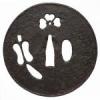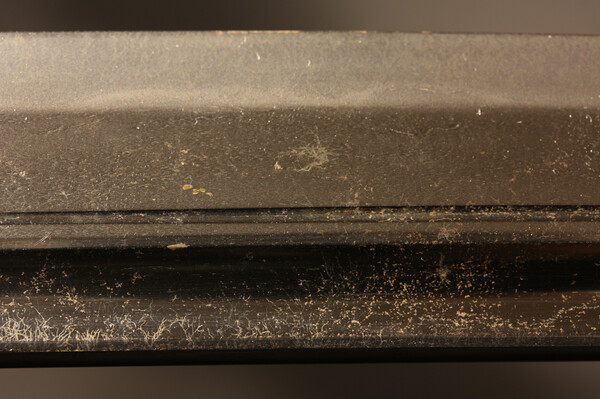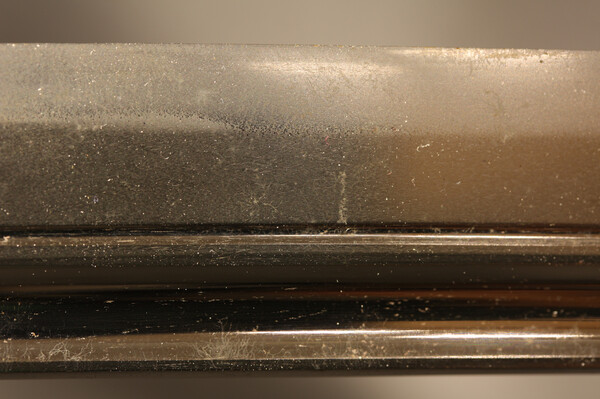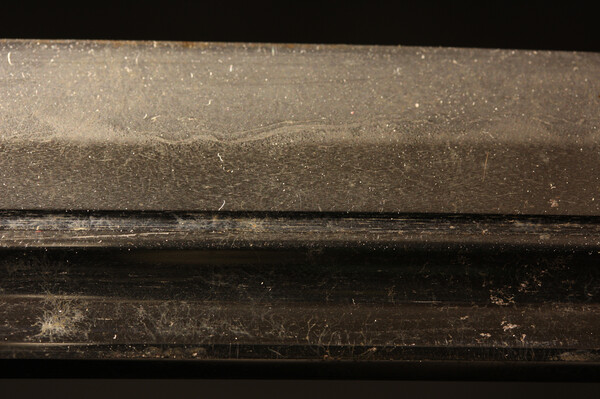-
Posts
1,271 -
Joined
-
Last visited
-
Days Won
1
Content Type
Profiles
Forums
Events
Store
Downloads
Gallery
Everything posted by hxv
-
Jim, Just a wild guess on my part, but the hamon is reminiscent of the Ishido school. Regards, Hoanh
-
Greetings, I have a sword that I would like to get your comments on regarding tradition, period, etc. 1. The nagasa is 24.75", osuriage. 2. It has bohi with soehi on both sides. The bohi stops slightly before the yokote, making me think it was added later, not original to the sword. 3. It's iori mune with a low roof, and the shinogiji is average - not high but not low. 4. The bohi and soehi look well done. Their depths and widths remain uniform over the length of the sword, and they remain parallel to each other. 5. The hada is fine itame. I don't see ji nie or utsuri at all. 6. The hamon is suguha, and the nioiguchi is consistently nie deki over the length of the sword. At first look, I thought this sword is Muromachi, but now I am not so sure. I am open to late Nambokucho/early Muromachi at this point. I think I can rule out Bizen (suguha hamon and lack of utsuri) and Mino (suguha hamon). I can also rule out Soshu (lack of ji nie and simple suguha hamon). That leaves Yamashiro and Yamato. Lack of a high shinogiji and the simple suguha hamon leads me to believe Yamashiro. I would appreciate you input and comments regarding the sword and/or my conjectures, good or bad. If you have a suggestion regarding school, that would be much appreciated as well. Regards, Hoanh
-
Mick, The signature is a bit hard for me to read, but I am guessing Toshikane. Your second picture seems to show that the boshi is a continuation of the hamon and would indicate a koto sword. Looking in Hawley, I would guess this is Toshikane in Mino, active around 1429 - Muromachi period. He signed with a two-character signature, so this would seem to fit. Have you considered purchasing some basic books to help with your study? Regards, Hoanh
-
Hoanh
-
Daniel, This thread will be helpful in your effort. viewtopic.php?f=9&t=18619&p=166805&hilit=evolution#p166805 Regards, Hoanh
-
Mick, Your sword seems to be very nice and well-made, but the mei is sketchy. I have looked up on the internet and found quite a few (papered) examples, one of which is posted here for comparison (http://www.sanmei.com/contents/media/S6 ... PUP_E.html). Regardless of whether the mei is valid or not, it is a nice sword. Congrats! Regards, Hoanh
-
100% in agreement with you, Paul. I think Jean was trying to make the same point with his facetious statement "and now time to buy my super loto ticket." Hoanh
-
For crying out loud, a genuine Inoue Shinkai daito, papered and in OK polish, can be had for much cheaper than this silly shill bidding charade. Go figure! Hoanh http://www.aoijapan.com/katana-inoue-iz ... i-kunisada
-
As pointed out already, 100% gimei without having to look up references. Hoanh
-
Mick, There are not enough photons hitting your camera's image sensor. Please increase the exposure time or use brighter lights. If the other side of the nakago is signed, it would take a lot of the guess work out of dating the sword. Also, please remove the sword from the scabbard and remove the habaki from the sword. Pictures of the overall shape of the bare blade, and close up pictures of the area under the habaki and of the tip will help greatly as well. Regards, Hoanh
-
Kory, The photographs don't show enough to tell anything about the hamon, hada, etc. As things stand, the pictures only show a shiny sword with a yakiba. I think, and I am putting myself out on the limb here, this is the reason that you have received no comment. May I suggest that you purchase some books and read through them, and as you read through your books, look at your sword to learn to recognize specific features. For instance, what type of nakago do you have? What is the nagasa? Sori? Is your yakiba nie deki or nioi deki? Do you see any ji nie? What type of hada do you see? What type of boshi do you have? Do you have hataraki in your yakiba, and what kind? The questions go on and on. Once you begin to recognize what your sword does have and does not have, then you can play with photography to show specific features on which you have questions. Perhaps once you know what features are looked for, you will also begin to understand why certain swords command prices and why other swords don't. Then you will recognize what type of sword is worth our limited financial resources to restore, while other swords, while genuine nihonto, lay by the way side. I wish you a very fun and addictive journey. Regards, Hoanh EDIT: Chris's post and mine crossed.
-
Christian, Yes, lucky me! I have never been happier. Hoanh
-
While the vast majority of swords with "Sa" mei are gimei, one does come across a gem once in a blue moon. Here is a naginata naoshi with a "Sa" kinzogan mei. At first blush, the kinzogan mei looks pretty questionable, but this sword does have NBTHK Hozon paper dated 1986 (new NBTHK system) with Sue Sa attribution, and the workmanship is exceptional. What's more impressive is that Hozon was issued without having to remove the kinzogan mei. Regards, Hoanh
-
The hada looks quite tight and nice. It'll be quite handsome after polish. Regards, Hoanh
-
Your sword badly needs a new polish, but from what little I can see, there seems to be a nice and active hamon. I can make out patches of nie in one of the pictures. The cost of properly restoring the sword - polish, new habaki, shirasaya - will run no less than $3k, and probably will be closer to $4k. It is a lot of money, and what you will end up with is essentially a mumei (assuming the gimei will be removed). From a financial point of view, it probably does not make sense. But, it probably will look gorgeous after restoration. Regards, Hoanh
-
Kory, Perhaps you can play with the angle of the lighting and the angle of the camera, and focus on a smaller segment of the sword, to try to show the hamon, hada, and hataraki. Regards, Hoanh
-
My immediate knee-jerk reaction is gimei. The sword has been shortened, and relative to the placement of the nakago ana (non-original), the mei and nengo look very, very suspect. Regards, Hoanh
-
Craig, The close up pictures help. The fittings (tsuba, fuchi, kashira, menuki) seem to be decent quality. I can't say the same about the blade, though. Although the blade is not a Chinese fake, but it is nothing to write home about, either. Regards, Hoanh
-
Peter, Thank you for relating your experience. I found a mumei wakizashi on ricecracker.com attributed to Kunisada http://www.ricecracker.com/japanese_swo ... hi/sw3.htm. Their photography is wonderful, as I know how hard it is to capture the jigane. I would be very interested to see pictures of your sword, if you don't mind. Regards, Hoanh
-
Gentlemen, Thank you so much for your comments. I left out the nakago so as not to bias your thinking/comments. Marius mentioned Soshu influence The sword is signed Izumi (no) Kami Kunisada (Inoue Shinkai's father), no date, and has Tokubetsu Hozon confirming the mei. The shape is stubby, somewhat short (25" nagasa), short nakago (like an uchigatana's nakago). The mei doesn't have "Fujiwara" like most of his mei, and given the shape & length of the sword, it's been placed in the early part of his career right after he receives his Izumi no Kami title (very early Shinto). As I said previously, it's a very unassuming sword until one looks carefully. Regards, Hoanh
-
Greetings, I have a sword that has taken me a long while to appreciate. On the surface, it's not flashy and is unassuming. It has take me a lot of hours, a magnifying glass, and macro photos to appreciate it. Part of the problem is that the sword is difficult to photograph. I have a couple pictures of the monouchi on both sides, and this is the easy part. The tough part is getting a good representation of the ji. I have tried my best with two pictures. If you don't look carefully, you will miss the evenly applied ji nie (see 3rd picture form the top, Ji_1.jpg) as the nie particles are relatively small and are not in-your-face. In fact the 3rd picture is a close up of a small area of the 4th picture, and looking at the 4th picture, one would easily miss the nie. The entire ji, over the length of the sword on both sides, sparkles when one views it, but it's very difficult to pinpoint why the ji sparkles. This point perplexes me for a long time until I discovers all of the ji nie that I missed. This was a big "ah ha" moment that I would like to share with you. Now, I understand the term "wet steel." Regards, Hoanh
-

New member need advice on my first nihonto
hxv replied to daytona1712's topic in General Nihonto Related Discussion
Teo, How fortuitous! A blade is just listed for sale by a long time member viewtopic.php?f=4&t=20274. It's a very nice blade and will keep you happy for a quite few years. Please have a look. Regards, Hoanh -

Need help translating first mei - Takai sada Tsugu?
hxv replied to Marc's topic in Military Swords of Japan
Joe, No problem at all, and your point is well taken. Regards, Hoanh



















